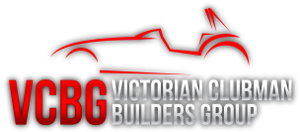Building a Clubman/Locost in Victoria.
Australian Design Rules
Clubmans in Australia are classified as Individually Constructed Vehicles (I.C.V’s). As such they are required to meet the CURRENT Australian Design Rules (ADR’s). This means the engine must pass currentemission requirements and all aspects of the vehicle must meet the applicable ADR’s. The list is a bit tedious, sometimes a bit ridiculous, and can be source of frustration. There is nothing difficult about the requirements. They simply mean you may be restricted in doing what you wish to do. If you undertake to build a clubman there will be plenty fellow builders to steer you in the right direction and offer their experience.
‘The requirements are there for your safety and nothing is gained by trying to get around them or fool your Engineer! All you will do is make it harder for everyone else and possibly end the ability to build ICV’s
The basic Victorian requirements can be found by clicking VIC Roads. You can view the files on line if you are able to view PDF files. Victorian ADR Requirements.
‘Some things to be aware of:’
- The ADR’s are applicable in all states of Australia, however each state interprets them in their own way. What passes in one state may not pass in another. If you are on a forum and you see some fact stated, make sure it applies in your state before you accept it as truth.
- Engineers are appointed by the Registration Branch in each state to test and access your ICV. You must use an approved Engineer, not just any Engineer. Your Registration Branch should be able to provide a list of approved Engineers. Your state clubman group will be able to tell you ‘clubby friendly’ engineers. By this I mean approved engineers who are familiar with clubman builds and have accessed these vehicles in the past.
- If you decide to start a build, contact an engineer and discuss what you intend to do. Like the States, you will find engineers also interpret the rules differently. What one engineer says is OK others will dispute. The bottom line is the Engineer is always right! If you make it hard for him – he will make it hard for you. This doesn’t mean you should not push your point, just don’t push him over the edge. If you are on a forum and you see some fact stated, make sure it is accepted by your engineer before you accept it as truth.
- Catch-22. If you meet all the ADR requirements, and then the engineer decides he wants something done that is not in the ADR’s; eg. He won’t pass without a roll bar; guess what – theres a little clause that says he has to be satisfied with the build. The Engineer is putting his reputation and livelihood on the line each time he passes a build and the buck stops with him. He has this right.
Starting / Engineering the Build:
Speak to builders and find an Engineer that you think you can work with. Discuss the build with him outlining what you wish to do, and find out what he will allow. Communicate by email if possible. This way you have record of what discussed and agreed to. The build may take several years and although you may remember promises and compromises he wont! You may also find that he changes his mind as a result of things that have happened since you discussed an issue with him. You will probably just have to accept that, remember Catch-22.
Your Engineer will tell you how many inspections he will require before issuing his approval, and at what stages he requires them. In Victoria your build date is the date you officially register your build with the engineer. This is usually when you have completed your space frame and have arranged to have it torsionally tested. The engineer will test the chassis, take photos, record all the details of what you intend to do (if he does not already have them) and provide you with the results of the test. In Victoria you now have 3 years to complete your build.
What happens if I don’t finish in time?
If you finish within 3 yrs you will be required to meet the ADR’s at the time you registered your build with your Engineer.
If you take longer your build will be dated 3 yrs from the completion date and you need to comply with the ADR’s that existed 3 yrs prior to your completion date. If the ADR’s changed after you registered your build, and you did not finish within 3 years, you may no longer meet the new requirements. You may have significant modifications to make and incur additional cost to make your build compliant to the new ADR’s. Basically, you need to comply with the ADR requirements, including emmissions, 3 yrs prior to the completion date of your build.
On Completion:
At the completion of your build your engineer will issue you with an engineering certificate. You will then be issued with a VIN number which needs to be stamped into the chassis. You take the vehicle, all appropriate documentation to the RTA office and get your rego plates. Appropriate documentation includes a roadworthy certificate. Technically you do not need a roadworthy for a new vehicle. Try convincing the RTA staff member who has asked where it is. Avoid the hassle, get one. You have just had your car engineered, it can’t fail! Walk out with the plates and then suck lemons for a month to try and get the smile off your face.[/et_pb_text][/et_pb_column] [/et_pb_row] [/et_pb_section]
